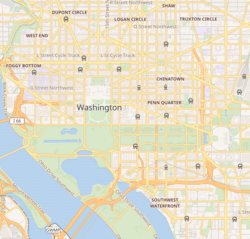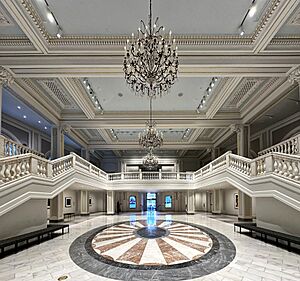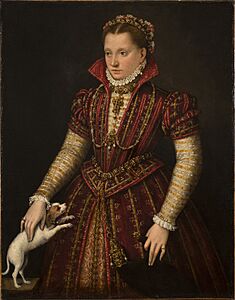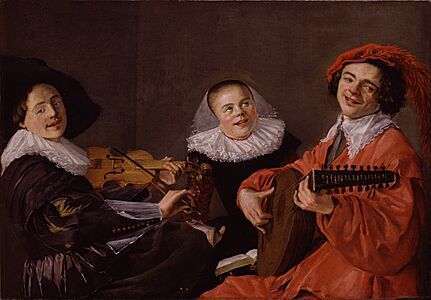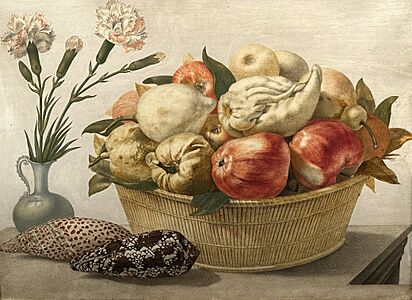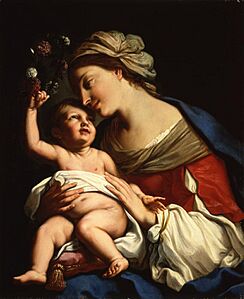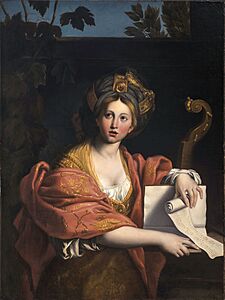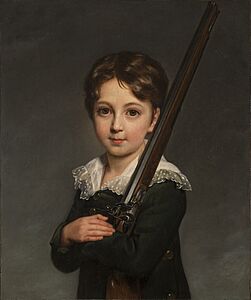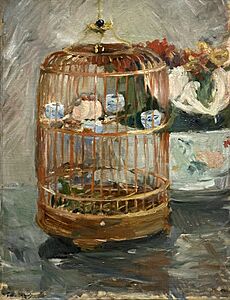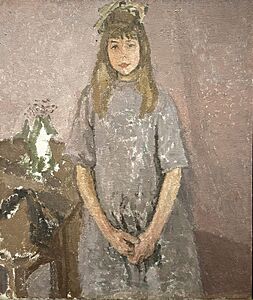National Museum of Women in the Arts facts for kids
Quick facts for kids |
|
|
Masonic Temple
|
|
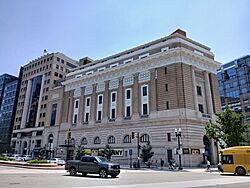
National Museum of Women in the Arts
|
|
| Location | 1250 New York Ave NW Washington, D.C., U.S. |
|---|---|
| Area | 0.3 acres (0.12 ha) |
| Built | 1903 |
| Architect | Wood, Donn & Deming |
| Architectural style | Classical Revival |
| NRHP reference No. | 86002920 |
| Added to NRHP | February 18, 1987 |
The National Museum of Women in the Arts (NMWA) is a special museum in Washington, D.C.. It is the first museum in the world completely dedicated to celebrating women through art. NMWA was started in 1981 by Wallace and Wilhelmina Holladay.
Since it opened in 1987, the museum has collected over 6,000 artworks by more than 1,000 artists. These artworks range from the 1500s to today. The collection includes pieces by famous artists like Mary Cassatt, Alma Woodsey Thomas, Élisabeth Louise Vigée-LeBrun, and Amy Sherald. NMWA also has the only painting by Frida Kahlo in Washington, D.C., called Self-Portrait Dedicated to Leon Trotsky.
The museum is located in an old building called the Masonic Temple. This building is listed on the U.S. National Register of Historic Places because of its historical importance. In 2021, the museum closed for a big renovation that cost $66 million. It reopened to the public on October 21, 2023, looking brand new!
Contents
History of the Museum
The museum was created to change how art history was traditionally told. It focuses on finding and sharing the work of women artists who might have been forgotten or not given enough credit. It also makes sure women artists today get the recognition they deserve.
The museum's founder, Wilhelmina Cole Holladay, and her husband Wallace F. Holladay, started collecting art in the 1960s. At that time, people were just starting to notice that women artists were not often shown in museums or big art shows.
They were very impressed by a painting from the 1600s by a Flemish artist named Clara Peeters. When they looked for information about Peeters, they found that major art history books didn't mention her or other women artists. This made them determined to collect art by women and eventually create a museum and research center just for them.
NMWA officially became a private, non-profit museum in December 1981. The art collection donated by the Holladays became the main part of the museum's permanent collection. After buying and fixing up the old Masonic Temple building, NMWA opened in April 1987. Its first exhibition was called American Women Artists, 1830–1930.
To show its dedication to women in all fields, NMWA asked Ellen Taaffe Zwilich, a composer who won a Pulitzer Prize, to write a special music piece. This piece was inspired by five paintings from the museum's collection and was played at the opening concert. As of 2022, Susan Fisher Sterling is the Director, leading a team of over 50 people.
The Museum Building
The museum building, which is about 78,810 square feet, is built in the Renaissance Revival style. It used to be the main office for the Grand Lodge of the District of Columbia, a group of Freemasons. It replaced an older building from 1870.
The main building was designed by architect Waddy B. Wood and finished in 1908. It was part of a plan to make Washington, D.C., more beautiful, known as the City Beautiful movement. Wood was known for supporting women architects during his life. The land for the building was bought in 1899.
When it was first designed, the top floors were for Masonic ceremonies. The middle floors were office spaces, and the first-floor auditorium was meant to be rented out for money. The building started showing silent films in 1916 after some changes. From 1941 to 1983, the auditorium was a public movie theater.
The Masonic Temple was almost torn down, but a local group called "Don't Tear It Down" stepped in to save it. In 1983, the Freemasons sold the building, and the National Museum of Women bought it. The inside of the building was renovated, and the old auditorium became a space for special events. The museum opened its doors to the public on April 7, 1987.
When it first opened, the museum had over 500 pieces in its permanent collection. These were displayed on the third floor, while changing temporary exhibits were on the second floor. Some people at the time worried that a museum just for women artists might separate them from the wider art world.
In 1994, the museum bought another nearby property for an expansion. The Elisabeth A. Kasser Wing, named after an art supporter, opened in November 1997. This new part added two new galleries, a bigger museum shop, and a reception room. It added 5,300 square feet, making the whole museum 84,110 square feet.
The museum closed in August 2021 for a major renovation, designed by Sandra Vicchio & Associates. This project made the gallery spaces larger and created a new area for researchers and educational programs. It also improved visitor facilities, accessibility, and storage for the museum's collection. The renovation added 2,500 square feet of gallery space and a learning center. The museum reopened on October 21, 2023. The renovation cost around $67.5 million to $70 million.
Wilhelmina Cole Holladay
Wilhelmina Cole Holladay (1922–2021) was the person who founded the National Museum of Women in the Arts and was the chair of its board. Holladay wanted to highlight the achievements of women by starting this museum.
She created groups of over 1,000 volunteers from 27 states and seven countries. These groups helped provide educational opportunities for children by working with schools and other community groups. They also encouraged adults to get involved in art in their local areas around the world.
Wilhelmina Cole Holladay became interested in art history while studying at Elmira College in New York. She then did more studies at the University of Paris. She is listed in important books like Who's Who of American Women and Who's Who in the World. She also received many awards for her work in the arts. In 2006, she received the National Medal of Arts from the United States and the Légion d'honneur from the French government. In 2007, she received the gold medal for the Arts from the National Arts Club in New York City.
New York Avenue Sculpture Project
The museum supported a project to place sculptures along New York Avenue in Washington, D.C. This was done to add "character" to an area that was being revitalized.
Works by Niki de Saint Phalle, four in total, were the first sculptures in this series. Her colorful pop art sculptures were chosen to be different from the traditional statues usually seen in Washington. All five main median strips in the road became "sculpture islands." The project also aimed to bring new and exciting contemporary art to Washington.
This project was supported by several groups and individuals, including the D.C. Downtown B.I.D. and the D.C. Department of Transportation. The sculptures stayed up for one year.
Museum Collection
-
Portrait of a Noblewoman (1580), Lavinia Fontana
-
The Concert (1631), Judith Leyster
-
Still Life with Basket of Fruit, Vase with Carnations, and Shells on a Table (1652), Giovanna Garzoni
-
Virgin and Child (1663), Elisabetta Sirani
-
Cumaean Sibyl (1763), Angelica Kauffman
-
Portrait of a young boy (1817), Élisabeth Vigée Le Brun
-
After the Storm (1876), Sarah Bernhardt
-
The Cage (1885), Berthe Morisot
-
The Little Model (1915–1920), Gwen John
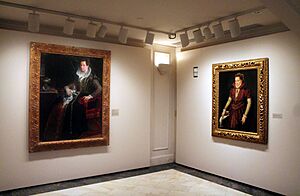
The museum's collection has over 4,500 artworks in many different styles and materials. These works span from the 1500s to today. One of the oldest pieces is Lavinia Fontana’s Portrait of a Noblewoman, from around 1580.
There are also special collections, like botanical prints from the 1700s. You can also see works by British and Irish women silversmiths from the 1600s to 1800s. The museum also has over 1,000 unique and limited edition artists’ books.
Nearly 1,000 artists are shown in the collection. Some of these include Magdalena Abakanowicz, Rosa Bonheur, Mary Cassatt, Judy Chicago, Helen Frankenthaler, Frida Kahlo, Angelica Kauffman, Käthe Kollwitz, Lee Krasner, Judith Leyster, Maria Sibylla Merian, Alice Neel, Clara Peeters, Rachel Ruysch, Elisabetta Sirani, Alma Thomas, Suzanne Valadon, and Élisabeth-Louise Vigée-Le Brun.
Betty Boyd Dettre Library and Research Center
The Betty Boyd Dettre Library and Research Center (LRC) helps people find information about women visual artists from all time periods and countries. It is open to students, researchers, and the public.
The LRC has 18,500 books and exhibition catalogs, 50 different magazines, and research files on 18,000 individual women artists. These files include things like resumes, letters, articles, and pictures. The Arts and Entertainment Network Media Library has about 500 videos, DVDs, and audio tapes. These include video art, interviews with women artists, and documentaries.
Researchers can also look at The Nelleke Nix and Marianne Huber Collection: The Frida Kahlo Papers. This collection has over 360 unpublished letters, postcards, notes, and drawings related to Frida Kahlo's life and work. The LRC also holds artist Judy Chicago's visual archives.
In 2007, the LRC launched "Clara: Database of Women Artists." This was an easy-to-use online tool to find information on almost 18,000 women artists from around the world. Clara has since been moved and is now part of the main NMWA website.
Exhibitions at the Museum
Since 1987, NMWA has hosted more than 200 exhibitions. Some of these include:
- Sonya Clark: Tatter, Bristle, and Mend (2021)
- Judy Chicago—The End: A Meditation on Death and Extinction (2019–2020)
- Rodarte (2018–2019)
- Women House (2018)
- Magnetic Fields: Expanding American Abstraction, 1960s to Today (2017–2018)
- She Who Tells a Story: Women Photographers from Iran and the Arab World (2016)
- Picturing Mary: Woman, Mother, Idea (2014–2015)
- Royalists to Romantics: Women Artists from the Louvre, Versailles, and Other French National Collections (2012)
- Women Who Rock: Vision, Passion, Power (2012–2013)
- Loïs Mailou Jones: A Life in Vibrant Color (2010–2011)
- WACK! Art and the Feminist Revolution (2007)
- Dreaming Their Way: Australian Aboriginal Women (2006)
- An Imperial Collection: Women Artists from the State Hermitage Museum (2003)
- Places of Their Own: Emily Carr, Georgia O'Keeffe, and Frida Kahlo (2002)
- Julie Taymor: Playing With Fire (2000–2001)
- The Magic of Remedios Varo (2000)
- Women to Watch (ongoing)
The Women to Watch exhibition series is a team effort between NMWA and its groups around the world. These shows happen every few years and feature artists from different regions. They focus on a specific art type or theme chosen by the museum's curators.
Murals
In 2020 and again in 2022, NMWA asked artists to paint murals on the plywood covering the museum's front while it was being renovated.
- Lookout: MISS CHELOVE, Artist: Miss Chelove (Cita Sadeli), (2022)
- Unnamed mural, Artist: Trap Bob (Tenbeete Solomon), (2020)
- Unnamed mural, Artist: Quest Skinner, (2020)
Public Programs
The museum offers public programs like hands-on workshops, talks with artists, gallery tours, and art history lectures. NMWA also provides training for teachers through its Art, Books, and Creativity (ABC) curriculum.
The museum's Women, Arts, and Social Change (WASC) program aims to encourage discussions about social and political issues that affect women. The program's Fresh Talk series invites the public to talk with women in the arts and other fields.
Outreach Committees
The museum started its network of national and international committees in 1984. As of 2022, there are 28 outreach committees with over 3,000 members in the United States and other countries. These committees help promote the museum's goals, support women artists in their regions, and act as ambassadors for NMWA. The committees also help present the museum's Women to Watch exhibition series, which features new or less-known artists from the areas where the committees are located.
Visiting the Museum
The museum is located at 1250 New York Avenue and H Street N.W. The closest Washington Metro stations are Metro Center or McPherson Square stations.
The museum is open Tuesday to Sunday from 10 a.m. to 5 p.m. Admission costs $16 for adults and $13 for adults aged 70 and older, and for D.C. residents. It is free for museum members, visitors aged 21 and under, and visitors with disabilities and their helpers. Admission is free for everyone on the first Sunday and second Wednesday of every month. The museum shop has the same hours as the museum.
See also
 In Spanish: Museo Nacional de Mujeres Artistas para niños
In Spanish: Museo Nacional de Mujeres Artistas para niños


